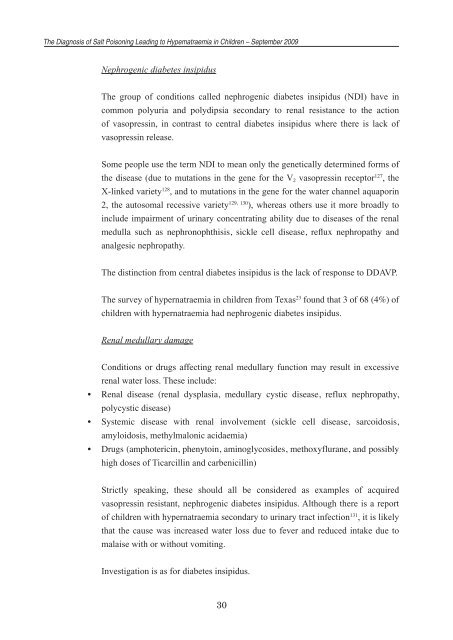The differential diagnosis of hypernatraemia in children, with ...
The differential diagnosis of hypernatraemia in children, with ...
The differential diagnosis of hypernatraemia in children, with ...
You also want an ePaper? Increase the reach of your titles
YUMPU automatically turns print PDFs into web optimized ePapers that Google loves.
<strong>The</strong> Diagnosis <strong>of</strong> Salt Poison<strong>in</strong>g Lead<strong>in</strong>g to Hypematraemia <strong>in</strong> Children – September 2009<br />
Nephrogenic diabetes <strong>in</strong>sipidus<br />
<strong>The</strong> group <strong>of</strong> conditions called nephrogenic diabetes <strong>in</strong>sipidus (NDI) have <strong>in</strong><br />
common polyuria and polydipsia secondary to renal resistance to the action<br />
<strong>of</strong> vasopress<strong>in</strong>, <strong>in</strong> contrast to central diabetes <strong>in</strong>sipidus where there is lack <strong>of</strong><br />
vasopress<strong>in</strong> release.<br />
Some people use the term NDI to mean only the genetically determ<strong>in</strong>ed forms <strong>of</strong><br />
the disease (due to mutations <strong>in</strong> the gene for the V 2 vasopress<strong>in</strong> receptor 127 , the<br />
X-l<strong>in</strong>ked variety 128 , and to mutations <strong>in</strong> the gene for the water channel aquapor<strong>in</strong><br />
2, the autosomal recessive variety 129, 130 ), whereas others use it more broadly to<br />
<strong>in</strong>clude impairment <strong>of</strong> ur<strong>in</strong>ary concentrat<strong>in</strong>g ability due to diseases <strong>of</strong> the renal<br />
medulla such as nephronophthisis, sickle cell disease, reflux nephropathy and<br />
analgesic nephropathy.<br />
<strong>The</strong> dist<strong>in</strong>ction from central diabetes <strong>in</strong>sipidus is the lack <strong>of</strong> response to DDAVP.<br />
<strong>The</strong> survey <strong>of</strong> <strong>hypernatraemia</strong> <strong>in</strong> <strong>children</strong> from Texas 23 found that 3 <strong>of</strong> 68 (4%) <strong>of</strong><br />
<strong>children</strong> <strong>with</strong> <strong>hypernatraemia</strong> had nephrogenic diabetes <strong>in</strong>sipidus.<br />
Renal medullary damage<br />
Conditions or drugs affect<strong>in</strong>g renal medullary function may result <strong>in</strong> excessive<br />
renal water loss. <strong>The</strong>se <strong>in</strong>clude:<br />
• Renal disease (renal dysplasia, medullary cystic disease, reflux nephropathy,<br />
polycystic disease)<br />
• Systemic disease <strong>with</strong> renal <strong>in</strong>volvement (sickle cell disease, sarcoidosis,<br />
amyloidosis, methylmalonic acidaemia)<br />
• Drugs (amphoteric<strong>in</strong>, phenyto<strong>in</strong>, am<strong>in</strong>oglycosides, methoxyflurane, and possibly<br />
high doses <strong>of</strong> Ticarcill<strong>in</strong> and carbenicill<strong>in</strong>)<br />
Strictly speak<strong>in</strong>g, these should all be considered as examples <strong>of</strong> acquired<br />
vasopress<strong>in</strong> resistant, nephrogenic diabetes <strong>in</strong>sipidus. Although there is a report<br />
<strong>of</strong> <strong>children</strong> <strong>with</strong> <strong>hypernatraemia</strong> secondary to ur<strong>in</strong>ary tract <strong>in</strong>fection 131 , it is likely<br />
that the cause was <strong>in</strong>creased water loss due to fever and reduced <strong>in</strong>take due to<br />
malaise <strong>with</strong> or <strong>with</strong>out vomit<strong>in</strong>g.<br />
Investigation is as for diabetes <strong>in</strong>sipidus.<br />
30

















